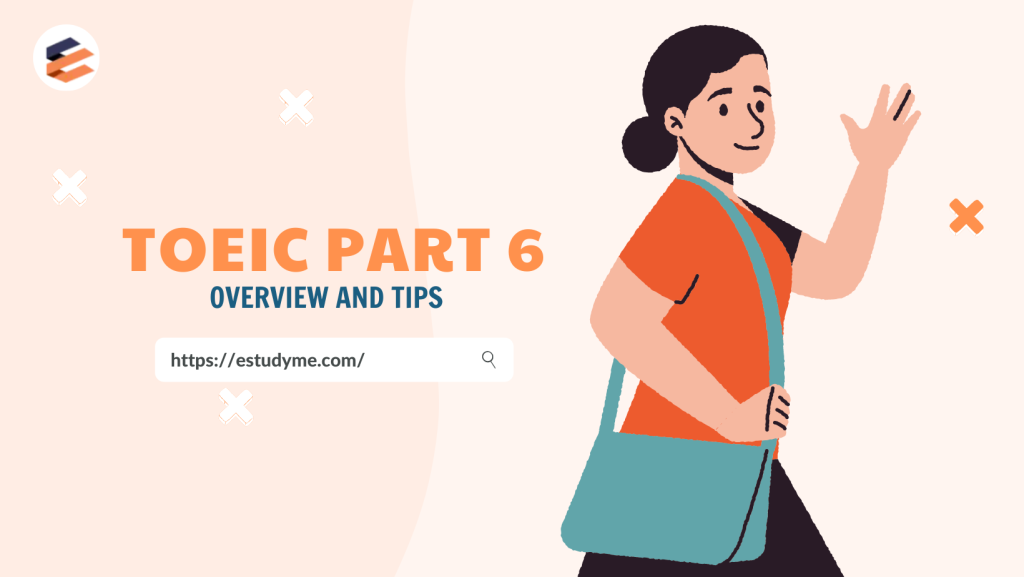TOEIC Part 6: Overview And Tips To Get High Scores
1. Toeic part 6 overview
1.1. Description of the task
In TOEIC part 6, you will have to read four passages of text. In each reading passage, there will be three blanks to fill in. You will read four possible choices for each blank. You should read the entire passage to make sure you choose the correct choice in context. TOEIC part 6 overview
TOEIC part 6 overview
1.2. Types of passage in TOEIC Part 6
- Letter - E-mail - Memo - Advertisement - Instruction - Article - Notice1.3. How to allocate time in TOEIC Reading Part 6?
The maximum time to complete TOEIC part 5 and 6 is 12 minutes. For each question, you will have a maximum of 30 seconds to transfer the answer in your answer sheet. You can allocate time as follow: - 10 seconds for each easy question - 30 seconds for each difficult question2. Tips to get high score in TOEIC part 6
2.1. It’s unnecessary to read the whole passage
Passages in TOEIC part 6 have the same length as ones in part 7 (single passages). Instead of consuming time on reading the whole passage, you just need to look at information before and after the blanks. By doing that, you can answer the questions quickly. TOEIC part 6 tips #1
TOEIC part 6 tips #1
2.2. If you do well in part 5, you may do well in part 6
If you do well in part 5, you may do well in part 6 because the requirements and types of questions in these two tasks are almost the same.2.3. Pay attention to lexical questions
In the new TOEIC Reading format, the number of lexical questions has accounted for 70-80%. To prepare thoroughly for this type of question, you need to constantly boost your vocabulary by reading as much as possible.2.4. Fully understand basic grammar
The number of grammatical questions in the new format has decreased considerably compared to those in the old format. Besides, grammatical questions in the new format are only at the basic level instead of the advanced level as before. The questions related to verbs are more frequently asked. To cope with this type of question, you need to understand usage of tenses properly. Also, removing wrong answers is also a good way to quickly choose the best answer.2.5. Learn collocations
When learning new words, don’t learn every single word, you should learn collocations. For example, instead of just learning the word “decision”, you should learn the phrase “make a decision”. By doing this, you can deal with part 6 effectively.3. Tricks in TOEIC part 6
 TOEIC part 6 useful tricks
TOEIC part 6 useful tricks
3.1. Words or structures with almost the same look but having different meanings
Example: For your protection, we suggest you ship via UPS. A replacement will be made and if the shoe style you returned is not available, a comparable style will be substituted. We guarantee to match the quality of the shoes you used to _______.- wear
- wearing
- worn
- be worn
| Used to V - Be / Get used to V_ing | - Used to V: talks about a past routine or situation which no longer exists at the present time - Be / Get used to V_ing: talks about the process of becoming familiar with something |
| Lose - Loss - Lost | - Lose (V_infinitive) - Lost: past simple + past participle - Loss (N) Some phrases often appear in the TOEIC exam such as get lost, the lost luggage, the lost property, etc. Lost is also used as an adjective. |
| Unable / Disabled | - Unable (adj): to not be able to do something Example: He is unable to run the business. - Disabled (adj): not having one or more of the physical or mental abilities that most people have Example: The accident left him severely disabled |
| Rise - Raise | - Rise (intransitive) - Raise (transitive) + object |
| Remember to V - Remember V_ing | - Remember to V: means having a memory of something in the past. - Remember V_ing: means recalling that there is something we need to do before we do it. |
3.2. Relative pronouns
Example: My apartment was in Crystal Heights, _______ might be OK for you. It’s only a 15 minute walk to the office and in a really nice part of Shelby. What’s your budget?- What
- Which
- That
- Who
| the preposition of place (in/ on/ at) + which = where |
| the preposition of time (in/ on/ at) + which = when |
| the preposition of purpose (for) + which = why |
3.3. Adjective and participles
Example: Ms. Monica Eisenman 555 King Street Auckland New Zealand Dear Ms. Eisenman: I am _____ to confirm our offer of part-time employment at Western Enterprises. In your role as research assistant, you will report to Dr. Emma Walton, who will keep you informed of your specific duties and projects.- pleased
- pleasure
- pleasant
- pleasing